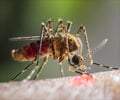
‘The recent Zika virus outbreak has highlighted the urgent need to establish genetic tools for studying how the virus multiplies and causes disease within a newly infected person in order to develop countermeasures.’
Tweet it Now
Replicons are segments of viral genome that can replicate on their own, independent of the cellular chromosome. The new Zika replicon system has deleted some of the genes that give the virus its structure. Because of this, the altered Zika virus is no longer infectious, lowering the safety risk involved in working with it. "One of these replicons can be used to locate portions of the viral molecule that block or halt viral replication, making it a powerful tool for vaccine development," said senior author Pei-Yong Shi, a professor in the department of biochemistry and molecular biology.
The replicon system was engineered by attaching genes that allow researchers to tag certain parts of the virus that they are interested in. Luciferase, the chemical that gives fireflies their signature glow, was used to make targeted viral components light up - making processes like replication much easier to observe.
"The other newly-developed replicon was designed to study potential antiviral agents by differentiating between when the virus is making copies of itself and when it's altering its structure," Shi said. "Knowing when and how the virus is mutating is important, as evolution is what makes viruses more adept at invading hosts like humans or animals or become more damaging once inside the host."
The recent Zika virus outbreak has highlighted the urgent need to establish genetic tools for studying how the virus multiplies and causes disease within a newly infected person in order to develop countermeasures. This is especially important because the Zika virus is spreading rapidly and behaves differently than many other viruses - for instance, it can be transmitted sexually and is associated with microcephaly and Guillain-Barre syndrome.
Advertisement











